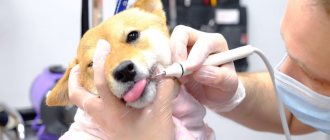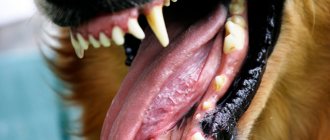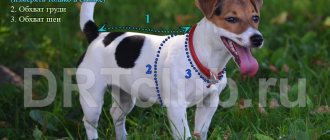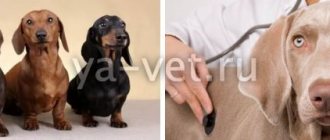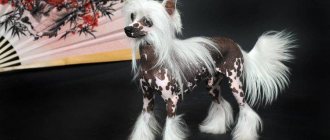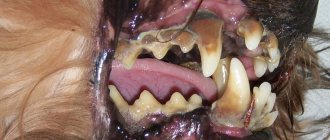Bite in dogs, the types of which can be different, is one of the points in assessing the animal. Unfortunately, the pet does not always meet the required standard due to incorrect positioning of the teeth. In such cases, it is better to consult a specialist - it is quite possible that everything can still be corrected. It is recommended to pay attention to the animal’s teeth and bite in order to detect the problem in time.
Correct bite is the basis for the health of your furry pet
Main types of bite
There are several types of bite patterns in dogs. They depend on the breed of the animal. Main varieties:
- scissor-shaped - is normal,
- pincer-shaped - the second name for straight,
- undershot,
- snacking is more common in bulldog-shaped dogs.
Depending on the dog's breed, the structure of the jaws, their length and development may vary. However, sometimes a distortion in the structure of the facial bones is possible.
Attention! A dog's bite is also affected by teeth - they can grow incorrectly, which is why various pathologies arise.
Types of bites
The concept of “correct bite” is individual for each individual breed; what is good for a Bulldog is a disqualifying defect for a German Shepherd. In a global sense, cynology distinguishes the following types of bites:
- Orthognathia, scissor or normal - the front of the lower incisors touches the back of the upper incisors, see photo below. There is no gap between the incisors, however, the teeth do not rub against each other. The bite is called normal due to its naturalness and prevalence. All wild canids have a scissor bite, which allows them to effectively gnaw meat and bones, bite and hold prey. Almost all service dogs have a normal bite, for example, Labrador, German and other shepherds, hunting dogs, hounds.
- Pincer-shaped or straight - when the jaw is closed, the front incisors come together end-to-end, the canines and chewing teeth close completely or not completely. Direct bite affects the health of the incisors, which wear out much faster. Incomplete closure of the chewing teeth leads to problems with chewing food, and as a result, indigestion. A very common deviation for small breeds, for example, Chihuahua, Yorkie, Spitz.
- Progenia, overshot, protruding chin or bulldog bite - the lower jaw, respectively, the incisors and/or canines protrude in front of the upper ones. Undershot is a breed trait for a number of dogs with a short muzzle, such as the Boxer.
- Prognathia or undershot is a disqualifying fault for all known dog breeds. The lower incisors do not touch the upper ones due to the shortened lower jaw.
- An asymmetrical or skewed bite, like an underbite, is guaranteed to disqualify a dog from breeding. Additionally, an asymmetrical bite can have serious consequences on both your dog's appearance and health.
Note! Defects of the dental system include not only the bite, but also a number of other deviations - impaired proportions of the jaws, incorrect number of teeth, abnormal structure of the jaw box and/or joints.
Scissor bite
Dogs have always been considered predatory animals. To survive, wild representatives have to constantly hunt. Their jaws are designed to grab and then hold prey. Therefore, a scissor bite is considered the most correct.
A similar structure is diagnosed in almost all dogs. Thanks to a scissor bite, teeth are less likely to wear down and the risk of disease is reduced. This jaw structure is typical for German shepherds, Labradors, terriers, Dobermans, Rottweilers, and Jagdterriers. Most breeds have a scissor bite.
According to the correct pattern, the front surface of the lower incisors quite tightly adjoins the back of the upper ones and abuts against their base. The fangs form a “lock”.
Correct positioning of teeth allows the dog to eat normally
Pincer bite
This type of bite is considered a problem and a defect for most dog breeds. However, it is not considered to be a very significant disadvantage.
In the pincer-shaped form, the upper and lower incisors rest against each other. As a result of this situation, they quickly wear down and the teeth become unusable. Fangs and molars are not affected.
The pincer-like arrangement of the jaws can be congenital or acquired.
Attention! This condition can occur when the puppy is played with a lot of tug games. As a result, the lower teeth may move forward.
Correct and incorrect bite in dogs
First, let's get acquainted with the norm. The small teeth that are located between the canines are called incisors. Fangs and incisors are used to capture food. Immediately following the canines are the premolars and molars, or molars. Their function is to chew.
The correct bite in dogs is scissor bite.
, is the standard for most breeds. When the jaws are closed, the lower incisors slightly extend beyond the upper ones, and the canines are in close contact with each other, while the lower canine should fit into the gap between the upper and the incisor. If we talk about malocclusion, there are several types:
- Underbite – the lower jaw is underdeveloped or the upper jaw is overdeveloped, which is why the lower incisors do not touch the upper ones.
- Overshot - the lower jaw is longer, and, accordingly, the lower incisors protrude forward. For some breeds, such as boxers, shih tzus, French and English bulldogs, this overbite is normal.
- Direct bite (pincer-shaped) - when, when the jaws are closed, the surfaces of the teeth touch end-to-end. This leads to premature wear and early loss of teeth.
- An open bite is when the mouth is closed and the teeth do not touch.
- Crooked bite is considered a severe hereditary defect and appears when one side of the jaw develops faster. One of the lower canines is often displaced inward and causes damage to the upper palate.
Underbite
An underbite in a dog is considered a more serious fault. Often such dogs are simply removed from various competitions. With this pathology, underdevelopment of the lower jaw is noted. As a result, there remains free space between the incisors, and the lower canines do not fit tightly to the edges of the upper jaw.
Unfortunately, underbite in a puppy often causes the development of various diseases. The remaining teeth are subject to great pressure and frequent destruction. In addition, tartar quickly forms. Therefore, the question of what to do if a puppy has an underbite worries many owners.
The most common is a scissor bite.
Snack
Underbiting in dogs can occur if the pet has short jaws. In some breeds, such a structure is considered normal and is not considered a defect. These varieties include bulldogs, Pekingese and bull terriers - these are dogs with a forward jaw.
When overbiting, the lower incisors are in front of the upper ones, while the lower jaw is slightly pushed forward. Some teeth may even become exposed.
Attention! Basically, this arrangement is also defective. However, for Cane Corso dogs, for example, a hearty snack is considered normal.
What other defects are found?
Unfortunately, these are not the only jaw problems that are possible. There are other variants of pathologies.
You may encounter a problem such as jaw misalignment. In this case, it does not close smoothly and empty spaces form between the incisors. The condition often becomes the development of various diseases in the dog.
Another defect develops as a result of improper growth and placement of teeth. Sometimes the fangs may be located closer to the center, which will also affect the position of the jaws.
Types of malocclusion
Dog handlers distinguish four main types of abnormal changes in dogs.
Straight
It is characterized by complete closure of the lower and upper incisors along one line. Leads to premature wear of the incisors. In this case, food is chewed poorly, which affects digestion and absorption of essential nutrients.
Children's undershot
Underbite is observed in puppyhood. It is characterized by a slight deviation of the lower jaw backward relative to the upper jaw. As a rule, it corrects itself when baby teeth are replaced with permanent ones.
Diagram of a dog's teeth seen from the front
The decision on the need for correction is made by a veterinarian - orthodontist.
In the article I talked about malocclusion in dogs. She described its main types and causes. She explained what the consequences are.
Why is the bite deformed?
There are several reasons for malocclusion. This phenomenon may be congenital, or it may become acquired over a period of time. Main reasons:
- Most often it is a genetic problem, which is why purebred dogs suffer, especially small breeds (Papillons, lapdogs, corgis). It is worth noting that puppies are carefully culled and are never used to breed dogs with jaw defects.
- Injuries can cause dental problems. Especially those that occur at a young age.
- Defects can develop due to a lack of nutrients and minerals. At the same time, the lack of such elements in a pregnant bitch will also have a negative impact on the puppy.
- Violent games, when there is a lot of stress on the jaw, can also provoke a problem in the future. As a result, a dog may grow up with teeth forward.
Attention! Malocclusion in pets can also be caused by poor nutrition and lack of nutrients, resulting in dental problems.
Incorrect positioning of teeth causes many problems for your pet.
What happens and what should be the bite in dogs?
A dog's bite is a form of closing of teeth. The correct bite is individual for each breed. What is good for a bulldog is a disqualifying fault for a toy terrier. And vice versa.
Cynology distinguishes the following types of dog bite depending on the form of closure of the teeth:
- Scissor bite (normal)
or orthodontics. The name comes from the similarity with the structure of scissors.
This form of closure of the teeth is determined by the tight fit of the incisors of the lower jaw to the back side of the upper jaw. Despite the absence of spaces between the teeth, they do not rub against each other, but form a kind of “lock”.
This form of teeth closure is justified from the point of view of dog physiology and is the norm for most breeds and wild relatives of our four-legged friends. Since this shape of the jaw allows the animal to gnaw bones, bite and hold the victim tightly in its teeth. As you can imagine, this is important for wildlife and almost all working breed dogs.
A normal scissor bite is also standard for the Toy Terrier.
Look at the photo of the correct bite of the toy terrier. In case of deviation, the dog is excluded from the breeding offspring, which is allowed for breeding.
- Direct (pincer) bite.
When the jaw is closed, the upper and lower incisors converge in one line, resting against each other. In this case, the closure of the canines and chewing incisors can be either complete or incomplete.
This type of teeth closure, due to the significant load on the front incisors, affects the strength of the chewing elements. They wear down much faster than with a scissor bite. At the same time, canines and chewing incisors are not ground down.
Congenital straight bite is associated with an initially incorrect position of the upper and lower jaws in relation to each other. And an acquired pincer bite is formed during the period of teeth change in a puppy, when the young dog is overly active in games with grabbing and tugging. As a result, the incisors of the lower jaw bend forward at an angle.
In Toy Terriers, a direct bite is allowed, which is characterized by an alveolar inclination of the incisors. Such dogs are not disqualified at exhibitions.
- Overshot or bulldog bite
(progenia, protruding chin). Everyone is familiar with this type of bite from the boxer or bulldog breed, in which the lower jaw protrudes in front of the upper jaw. Moreover, the lower incisors and canines are often exposed. This form of teeth closure is a kind of calling card of these breeds, since the facial bones of these animals are shortened. - Undershot (prognathia)
. A disqualifying pathology, which is expressed in a shortened lower jaw, due to which the lower incisors do not close with the upper ones.
Causes of malocclusion in dogs.
The cause of malocclusion in dogs in most cases is genetics. Therefore, breeders pay special attention to preventing animals with such a deviation from being bred.
However, there are other reasons for the appearance of improper formation of chewing elements in a toy terrier.
And these include:
- violation of feeding requirements. First of all, this concerns the lack of minerals in the diet of a pregnant dog and puppies.
- jaw injury in puppyhood.
- active games that emphasize grasping and tugging with teeth. Excessive load leads to sad consequences.
- Toy terriers have problems when replacing primary premolars with permanent ones. So, timely removal of primary premolars will enable the timely development of permanent teeth and save you from problems with improper teeth closure in the future.
Correcting bite in dogs.
Correcting a dog's bite is very difficult; it is easier to pay attention to the animal's oral cavity than to correct the position of the jaw and teeth.
For puppies during the period of formation of the change from the primary dentition to the permanent one, it is important to pay attention to the pet’s nutrition. The diet should contain minerals such as calcium and phosphorus. When feeding your Toy Terrier puppy with ready-made dry food, choose food that contains these minerals. If your dog eats natural food, then add it to his food, the dosage and composition of which must be agreed with your veterinarian.
If Toy Terrier puppies have dental problems, an ideal bite can be formed using the services of veterinarians who specialize in dentistry and orthodontics. They place a special rubber ring on the teeth, which straightens the incisors and fangs.
In adult Toy Terriers, the shape of the closure of the teeth can be corrected using canine braces. Teeth that need to be slightly moved or rotated can be adjusted. To do this, permanent wire connections are placed on the dog’s teeth. The material used is medical stainless steel or nickel-titanium alloy.
The wire connections press on the tooth and since the connection between the tooth and the jaw is not rigid, the incisor or canine begins to move little by little in the desired direction. And the vacated space is filled with bone tissue. Braces are an individual device. For those terriers who have an allergic reaction, ulcerative stomatitis, gingivitis and others, braces are contraindicated. In all other cases, the veterinarian will install a device that corrects the bite and tell you how to care for it.
In this article I will talk about malocclusion in dogs. I will describe its main types and causes of occurrence. I will explain what the consequences are and how to fix it.
The correct bite in dogs is a scissor or scissor bite: at the moment the jaws join, the back teeth of the upper teeth meet as tightly as possible with the incisors of the lower one.
Occlusion is the nature of the position, closure and relationship of the upper and lower jaws with maximum contact and complete closure of the teeth.
Scissor bite in a puppy
How to prevent the development of defects
To prevent the development of defects in the animal, it is recommended to try to exclude all possible causes. Prevention is a correct and balanced diet, including all the necessary elements.
With a small puppy, you need to play tug games very carefully so as not to disturb the position of the teeth, otherwise you end up with a dog with a protruded jaw, which is very difficult to correct.
It is recommended to carefully examine the dog’s oral cavity from childhood, especially during the period of change in the primary bite. If problems arise, you need to consult a specialist - remove the baby tooth or correct the bite with the help of special devices (at a young age this is much easier to do).
Consequences of malocclusion for a dog's health
An incorrect bite causes certain inconvenience to the dog, and the consequences of such a pathology can be completely sad:
- The inability to chew food normally leads to various pathologies of the gastrointestinal tract.
- Severe malocclusion may result in oral injury.
- When the jaws do not close tightly, there is a constant release of saliva, which can cause various skin diseases.
If deviations from the norm are mild, they rarely cause problems for the dog. However, in any case, it is better to go to the clinic. Even an uneven row of lower incisors in a dog can cause the development of pathologies.
Pathological bites
Pathologically malocclusions include:
In addition, there are common disorders in the development of the dental system:
- teeth that grow in two rows;
- lack of teeth or extra teeth appear;
- shortened bridle;
- the appearance of a crossbite - the lower incisors overlap the upper ones when the jaw closes;
- skewed bite – a defect that occurs due to improper formation of the apparatus;
- open bite is a pathology in which the front incisors form a gap when the jaw is closed.
There are many defects that harm the animal to one degree or another, quite often leading to more serious disturbances in the functioning of the body.
The chewing apparatus belongs to the gastrointestinal tract and is considered its beginning. Therefore, any deformations of the teeth and jaws negatively affect the digestive processes and have the following manifestations:
- Eating food may be difficult, the dog cannot chew it fully, which provokes gastrointestinal disorders;
- with severe malocclusion, there is a risk of injury to the oral cavity;
- When the jaws are not closed tightly, the dog constantly drools, which causes weeping eczema and other dermatological diseases.
If the animal exhibits small deviations from the norm, and they do not affect the quality of life, then the bite may not be corrected. But usually the decision on the need for correction is made by a veterinarian - an orthodontist.
Fixes
In some cases, your doctor may suggest trying to straighten your dog's bite. For this purpose, two types of devices are used:
- Removable devices
These are transparent aligners that are removed if necessary - while eating and brushing your teeth. The rest of the time the dog constantly stays in them.
The aligners constantly put pressure on the teeth, causing them to move into the required position. Must be replaced every few months.
For puppies, ring-braces made of hard rubber are offered; they exert a little less pressure.
- Fixed structures
Such devices are made of fairly dense material and are placed on the teeth, after which they are adjusted using a special wire and clasps. If necessary, you can adjust the pressure force.
There are various ways to correct an animal's bite.
Causes of malocclusion in dogs
If signs of deformation or a change in the defect in the dog’s teeth are detected, dog handlers will disqualify the representative of the breed. Therefore, if a puppy is purchased and raised for a show career and further breeding, careful attention must be paid to the teeth.
The main reasons for the formation of incorrect teeth position are:
- genetic predisposition. Dogs with improperly positioned teeth are discarded from breeding so as not to worsen the breed characteristics of future litters. Therefore, before purchasing a puppy, it is necessary to establish the fact that the descendants have the correct one;
- poor quality and unbalanced nutrition. A lack of vitamins and microelements necessary for the growth and development of teeth leads to disturbances in the structure of the teeth and jaw as a whole. To prevent pathology, the puppy must receive good nutrition appropriate for its age and be exposed to natural sunlight for up to two hours a day;
- metabolic disorders lead to improper absorption of nutrients entering the body and their subsequent deficiency. In addition to quality nutrition, the dog must receive daily physical activity in accordance with breed and age standards. It is also necessary to treat all diseases in a timely manner to prevent disruptions in the body’s functioning and subsequent complications;
- Violation of the schedule for changing baby teeth, in the form of premature eruption of molars when temporary teeth have not fallen out, leads to displacement and curvature of new permanent teeth. If deviations occur in the schedule for changing teeth, it is necessary to visit a veterinarian to correct the situation;
- injuries to the jaw, such as blows, strong pressure (when a dog digs its teeth into something and pulls hard), gnawing hard objects (for example, bones) also causes curvature of the teeth and jaw. The puppyhood period is the most important period in the development of a dog's bite. Until all of the dog’s single-rooted teeth grow out, it is necessary to observe safety measures to injure the jaw (do not play tugging with objects with the puppy, do not allow the puppy to gnaw on bones or other hard substances, try to avoid possible injuries). In case of jaw injury, you should immediately contact a veterinarian for examination.
When assessing a dog’s exterior, dog handlers always look to see if its jaws and teeth are connected correctly.
Contraindications to orthodontic treatment
The use of special designs is not permitted in all cases. Contraindications for dogs with malocclusion are:
- periodontal disease,
- allergic reactions to the materials from which the systems are made,
- stomatitis,
- gingivitis,
- formations in the oral cavity.
If necessary, you can even install dentures, but there must be a doctor’s prescription.
An incorrect bite can cause many problems in a dog's life. To maintain your pet’s health, it is recommended to monitor the development of your pet’s teeth from early childhood and take the necessary measures in a timely manner. It is important to monitor the dog’s nutrition and hygiene and provide the dog with proper care.
Consequences of malocclusion in dogs
In each individual case, the need and expediency of correction must be determined by a veterinarian. If we start from the facts, then the wrong consequences of a malocclusion in a dog, indeed, often lead to injuries to the palate, tongue, gums and other dental problems. And poor-quality chewing of food unnecessarily loads the digestive system.
But sometimes a slight deviation does not prevent the animal from living a full life and does not cause harm. Then there is no need to correct the bite. In any case, such dogs no longer participate in exhibitions and are not used for breeding.
How does the deviation develop?
- Games that put a lot of stress on your teeth. This mistake is often made by owners of fighting breed dogs, for some reason believing that from early childhood the animal should carry bricks, rays in its teeth or hang from a stick.
- Impaired development of the jaw and teeth can be caused by poor nutrition, or rather, a lack of minerals in the diet.
- Jaw trauma sustained in childhood often leads to impaired bone formation and changes in bite.
- And, of course, heredity plays an important role.
A dog that has even minor pathologies is not allowed to breed.
Puppies are always born without teeth. The first baby tooth appears only after a few weeks. True, in just two to three months the deciduous row is fully formed and has 28 teeth. Almost immediately the change from dairy products to indigenous ones begins.
At the age of 7-8 months, the animal should have a fully formed dentition, which consists of 42 permanent teeth. But in some animals this amount may be less, then they speak of partial teeth (oligodontia). If there are more teeth, then polyodontia or polyodontia.


